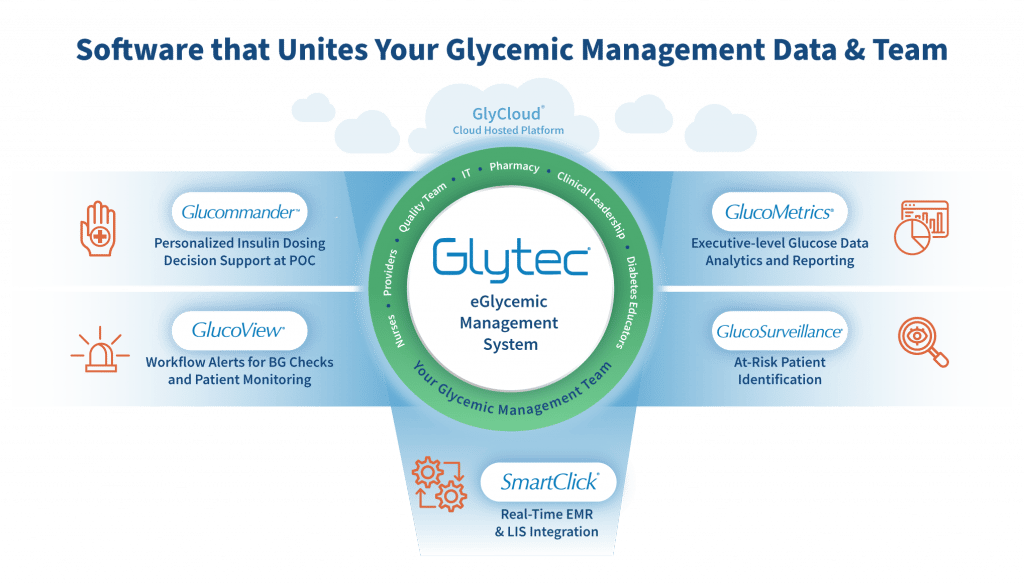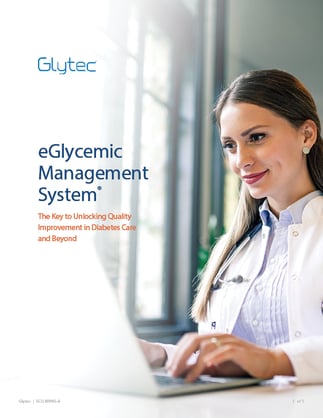By providing a high-reliability strategy for achieving the standard of care in glycemic management, Glytec’s eGlycemic Management System (eGMS) can help improve the quality of inpatient diabetes care and positively impact organization-wide quality measures including readmissions2 and length of stay.1
Glucommander, our FDA-cleared decision support software that forms the core of eGMS, replaces outdated one-size-fits-all protocols for IV and SubQ insulin and reduces the risk of medication errors while maximizing workflow efficiency for doctors and nurses.4
Meanwhile, Glytec’s GlucoMetrics module automatically aggregates hospital-wide and unit-wide glycemic management quality data and presents it for analysis, providing real-time visibility into performance.
With these modules and more, eGMS makes glycemic management easier for providers, safer for patients and better for the bottom line.
Results from real hospitals using Glytec’s eGMS

In addition, use of eGMS helped improve standard-of-care basal bolus insulin utilization at one hospital from 5% to 96%.5
What does eGMS do?

Glytec’s comprehensive eGlycemic Management System supports quality improvement throughout the continuum of care by uniting your glycemic management team and data. Here’s how it works:
Glucommander: Our algorithm-driven insulin dosing decision support software sits at the core of eGMS. Glucommander is FDA-cleared and approved for use in IV, SubQ and outpatient settings for both adult and pediatric patients.
SmartClick: eGMS integrates directly with the EMR to support one-click access, reduce redundant data entry, reduce transcription errors and improve workflow efficiency for providers.
GlucoView: Providers can use eGMS to view a dashboard of glycemic status indicators for all patients in a unit, helping nurses track last BG test results and current infusion rates and see precisely when the next check is due.
GlucoMetrics: eGMS provides insights into organizational glycemic management performance by tracking KPIs like incidence of hyperglycemia and hypoglycemia, time to target, patient utilization and more.
GlucoSurveillance: eGMS interfaces with laboratory information systems to continuously analyze patient blood glucose values of patients not using Glucommander and alert staff about at-risk patients.
GlyCloud: eGMS is hosted in the cloud, which means it can be installed, configured and updated remotely. Your data is secured at a HIPAA-compliant data center.
How does eGMS unlock quality improvement?
Our FDA-cleared algorithm replaces outdated and complex paper protocols and simple but unsafe sliding scale protocols while making work easier for providers, helping increase the stickiness of QI initiatives.
GlucoMetrics provides specific patient, unit-wide and organizational glycemic management data, helping quality teams gain buy-in for interventions and improve communication with providers.
EMR integration reduces transcription errors, stacked doses and other mistakes that can increase the risk of adverse drug events.
Automated reminders increase timeliness of BG checks by providers and improves care.
GlucoSurveillance and Glucose Velocity Warning alert providers about patients at risk for hyperglycemia and hypoglycemia.
Improvements in glycemic management impact toplevel quality indicators like readmissions and length of stay.
References:
- Safely Converting an Entire Academic Medical Center From Sliding Scale to Basal Bolus Insulin via Implementation of the eGlycemic Management System. Journal of Diabetes Science and Technology, Jan 2018.
- Relationship Between Glycemic Control Using eGMS and Readmission Rates in Cardiovascular Patients Hospitalized with AMI, CHF or Undergoing CABG During the Implementation of a System Wide Glycemic Initiative. Diabetes Technology Meeting, Nov 2016.
- Risk of Hypoglycemia During Insulin Infusion Directed by Paper Protocol Versus Electronic Glycemic Management System in Critically Ill Patients at a Large Academic Medical Center. Journal of Diabetes Science and Technology, Jan 2018.
- Use of Technology Reduces Incidence of Hypoglycemia-Related Adverse Drug Events Among Patients Requiring Insulin Therapy While Hospitalized. DTS Virtual Poster Meeting, Jun 2020.
- Safely Converting From Sliding Scale to Basal Bolus Insulin Across an Entire Medical Center via Implementation of the eGlycemic Management System. American Diabetes Association Scientific Sessions, Jun 2017.
ECO #0965-A


.webp?width=650&height=100&name=Sentara-Healthcare_CTA%20(1).webp)